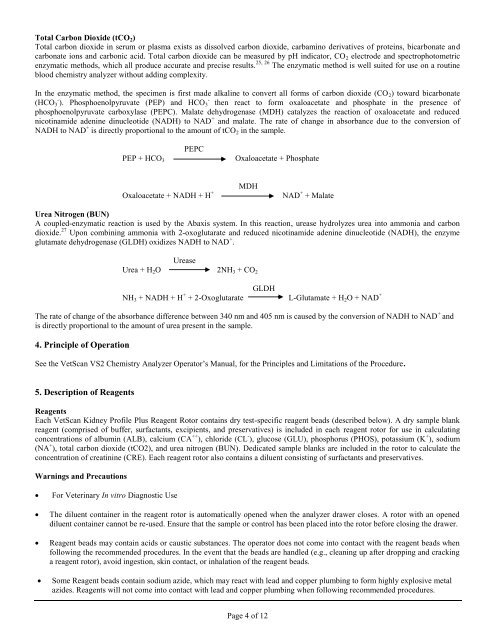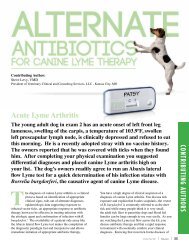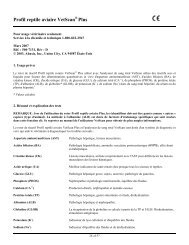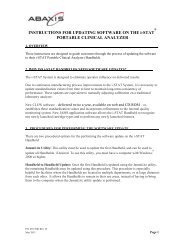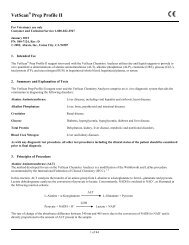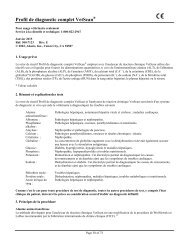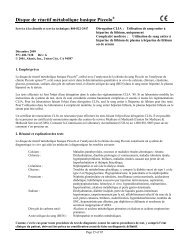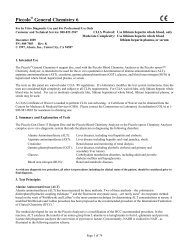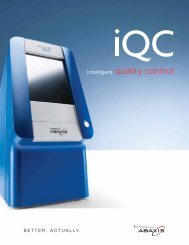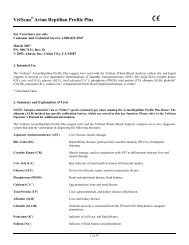VetScan® Kidney Profile Plus - Abaxis
VetScan® Kidney Profile Plus - Abaxis
VetScan® Kidney Profile Plus - Abaxis
Create successful ePaper yourself
Turn your PDF publications into a flip-book with our unique Google optimized e-Paper software.
Total Carbon Dioxide (tCO 2 )<br />
Total carbon dioxide in serum or plasma exists as dissolved carbon dioxide, carbamino derivatives of proteins, bicarbonate and<br />
carbonate ions and carbonic acid. Total carbon dioxide can be measured by pH indicator, CO 2 electrode and spectrophotometric<br />
enzymatic methods, which all produce accurate and precise results. 25, 26 The enzymatic method is well suited for use on a routine<br />
blood chemistry analyzer without adding complexity.<br />
In the enzymatic method, the specimen is first made alkaline to convert all forms of carbon dioxide (CO 2 ) toward bicarbonate<br />
(HCO - -<br />
3 ). Phosphoenolpyruvate (PEP) and HCO 3 then react to form oxaloacetate and phosphate in the presence of<br />
phosphoenolpyruvate carboxylase (PEPC). Malate dehydrogenase (MDH) catalyzes the reaction of oxaloacetate and reduced<br />
nicotinamide adenine dinucleotide (NADH) to NAD + and malate. The rate of change in absorbance due to the conversion of<br />
NADH to NAD + is directly proportional to the amount of tCO 2 in the sample.<br />
PEP + HCO 3<br />
PEPC<br />
Oxaloacetate + Phosphate<br />
Oxaloacetate + NADH + H +<br />
MDH<br />
NAD + + Malate<br />
Urea Nitrogen (BUN)<br />
A coupled-enzymatic reaction is used by the <strong>Abaxis</strong> system. In this reaction, urease hydrolyzes urea into ammonia and carbon<br />
dioxide. 27 Upon combining ammonia with 2-oxoglutarate and reduced nicotinamide adenine dinucleotide (NADH), the enzyme<br />
glutamate dehydrogenase (GLDH) oxidizes NADH to NAD + .<br />
Urease<br />
Urea + H 2 O 2NH 3 + CO 2<br />
GLDH<br />
NH 3 + NADH + H + + 2-Oxoglutarate L-Glutamate + H 2 O + NAD +<br />
The rate of change of the absorbance difference between 340 nm and 405 nm is caused by the conversion of NADH to NAD + and<br />
is directly proportional to the amount of urea present in the sample.<br />
4. Principle of Operation<br />
See the VetScan VS2 Chemistry Analyzer Operator’s Manual, for the Principles and Limitations of the Procedure.<br />
5. Description of Reagents<br />
Reagents<br />
Each VetScan <strong>Kidney</strong> <strong>Profile</strong> <strong>Plus</strong> Reagent Rotor contains dry test-specific reagent beads (described below). A dry sample blank<br />
reagent (comprised of buffer, surfactants, excipients, and preservatives) is included in each reagent rotor for use in calculating<br />
concentrations of albumin (ALB), calcium (CA ++ ), chloride (CL - ), glucose (GLU), phosphorus (PHOS), potassium (K + ), sodium<br />
(NA + ), total carbon dioxide (tCO2), and urea nitrogen (BUN). Dedicated sample blanks are included in the rotor to calculate the<br />
concentration of creatinine (CRE). Each reagent rotor also contains a diluent consisting of surfactants and preservatives.<br />
Warnings and Precautions<br />
<br />
<br />
<br />
<br />
For Veterinary In vitro Diagnostic Use<br />
The diluent container in the reagent rotor is automatically opened when the analyzer drawer closes. A rotor with an opened<br />
diluent container cannot be re-used. Ensure that the sample or control has been placed into the rotor before closing the drawer.<br />
Reagent beads may contain acids or caustic substances. The operator does not come into contact with the reagent beads when<br />
following the recommended procedures. In the event that the beads are handled (e.g., cleaning up after dropping and cracking<br />
a reagent rotor), avoid ingestion, skin contact, or inhalation of the reagent beads.<br />
Some Reagent beads contain sodium azide, which may react with lead and copper plumbing to form highly explosive metal<br />
azides. Reagents will not come into contact with lead and copper plumbing when following recommended procedures.<br />
Page 4 of 12


